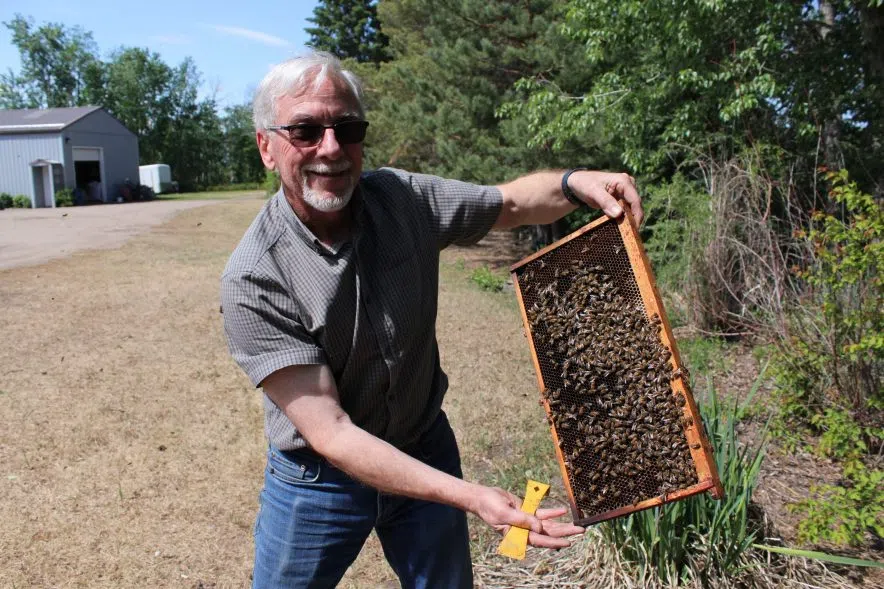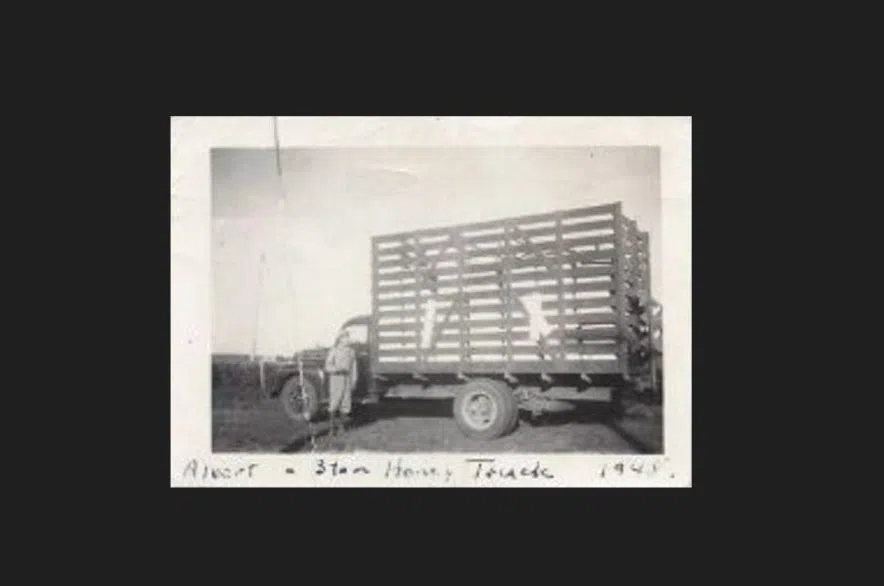SHELLBROOK, SASK. — In the early light of a Saskatchewan morning, the hum of bees fills the air.
A boy shadows his father, wide-eyed, trailing through the wildflowers and canola blossoms that dance in the prairie breeze. The soft curl of smoke from a bee smoker mingles with summer air. There’s no rush, only the quiet reverence of a man who understands his bees like old friends and a boy who watches and learns.
These are some of Murray Hannigan’s earliest memories with his father, Albert Hannigan — a man who built something sweet and enduring from a single spark of wartime necessity.
“My dad started in 1940. He was passionate about beekeeping,” Murray told 650 CKOM. “And he passed that on to me.”
Albert Hannigan died eight years ago, but his life lessons still buzz through the hives and through Murray’s heart.
This Father’s Day, we honour the dads who teach by doing, and whose legacies live on in the quiet, steady work they leave behind.
Read more:
- Vintage quilts, modern coats: A Saskatchewan crafter’s cozy transformations
- Answering the call: Inside a rural Sask. addiction recovery centre
- The Bird Lady: Meet the Saskatoon woman rescuing abandoned parrots
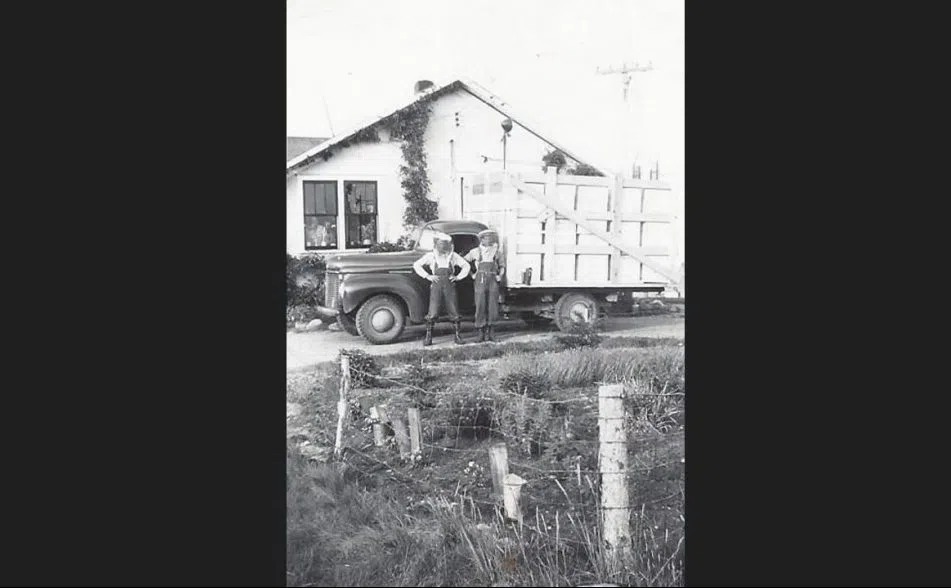
Albert Hannigan’s love of beekeeping started early with a hive at 16 and a curiosity that wouldn’t quit. “He would say to me years later, ‘You know, I don’t know how that hive made any honey that first year, because I was into it every day.’ So he really enjoyed it,” his son Murray said. (Submitted)
Albert was just 16 when he ordered his first bees through the Eaton’s catalogue. Sugar was being rationed during the war, and his mother, Cora, needed a solution. What started as one hive to help stretch the family’s sugar supply soon grew into a lifelong obsession.
Listen to Brittany Caffet’s feature with the Hannigan family
“He couldn’t get enough of it,” Murray shared with a smile. “He would say to me years later, ‘I don’t know how that hive made any honey that first year, because I was into it every day.’”
Albert’s devotion to his bees became the foundation of Hannigan Honey, a business that now spans more than 6,000 hives across 140 locations in Saskatchewan.
But beyond the numbers and the honey, what endured most are the lessons Albert passed on to his son. Lessons not written in any manual, but carried in the golden thread that binds one generation to the next.

From one hive to thousands, Albert Hannigan built more than a business. He built a legacy rooted in hard work, honey and heart. (Submitted)
Lesson one: Build it yourself (even if you’re just in it for the candy)
One of the first lessons Albert taught his children was the value of a dollar and the satisfaction of earning it with your own two hands.
“When he wanted to expand, all seven of us had jobs building bee frames,” Murray recalled. “We got paid ten cents a frame. As kids, we wanted pocket money to buy candy.”
It may have started with a sweet tooth, but it turned into a lesson in ownership, discipline and hard work.
Frame by frame, hive by hive, the Hannigan children helped build something real. It was a lesson in entrepreneurship, craftsmanship, and what it meant to contribute — even as a kid.
Lesson two: Work hard, rest harder
Albert Hannigan didn’t believe in shortcuts, but he did believe in naps.
“My dad had the ability to work long, long hours,” Murray said. “Even into his 70s and 80s, he could still put in a full day.”
But it turns out that even the busiest of bees need a break now and then.
“He would do well with a power nap,” Murray recalled with a laugh. “So, you know, he was getting into his, say, his 60s, and maybe even his 70s, and we’d be out at the bees, and he’d say, ‘Oh, I just need to take a little break, you know?’ And so he’d lay in the shade of the truck with his bee veil on, have a 20-minute rest, and then right back to work.”
It wasn’t laziness. It was knowing your limits. Albert didn’t waste time, but he knew how to respect it. And that, too, was a kind of wisdom he passed on.

These hives hum with more than honey — they carry the sound of a legacy, passed down from father to son, season after season. (Submitted)
Lesson three: A little curiosity goes a long way
For Albert Hannigan, being a leader wasn’t about being right; it was about being willing to grow. And it created space for others to grow, too.
“One of his management styles was to let people thrive,” Murray said. “Encourage people and show them, and then let them make a few mistakes. You’re going to learn. Then we can talk about what went wrong, or what went right.”
Albert didn’t hover. He believed in letting people find their way. He was a teacher, not a taskmaster, and celebrated every little victory along the way.
“He really was a cheerleader for our successes,” Murray added. “We’ve had some high points in the last five years where I would’ve liked to have said, ‘Dad, guess what? We got this tremendous market in Japan,’ and he would have just been on board. It would have been great.”
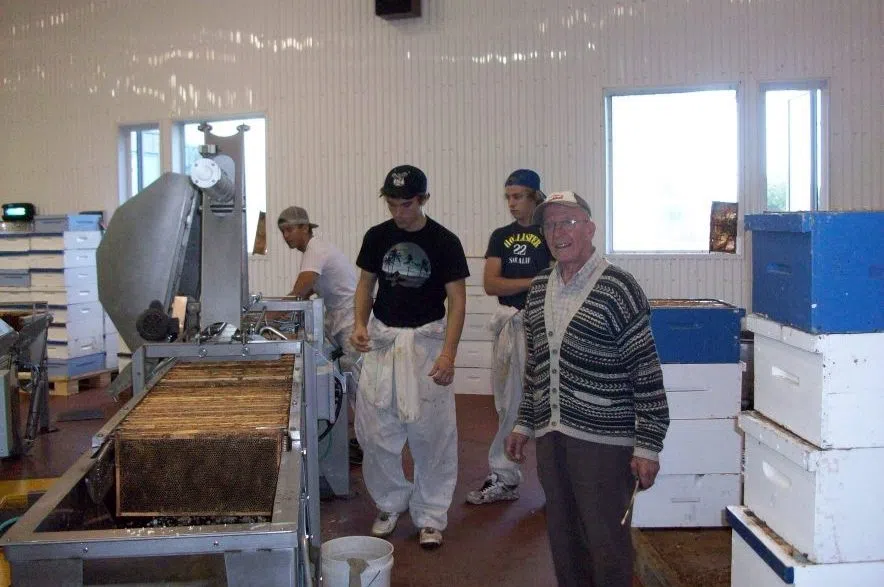
Albert Hannigan didn’t just build the business, he stuck around to see it thrive. Even as the years added up, the bees and the barrels still called him in. (Submitted)
Lesson four: The bees don’t care about your schedule
In beekeeping — as in life — the plan is only a starting point.
“You have to be flexible,” Murray said. “You can’t just knock down a calendar and say, ‘Here’s what we’re going to do this week, that week, and the next.’ Weather, climate, parasites… they all change the game.”
Albert knew this. He didn’t cling to rigid routines or stubborn ways. He watched, he listened and he adjusted.
He taught his son that success wasn’t about sticking to the script, it was about reading the signs and adapting fast.
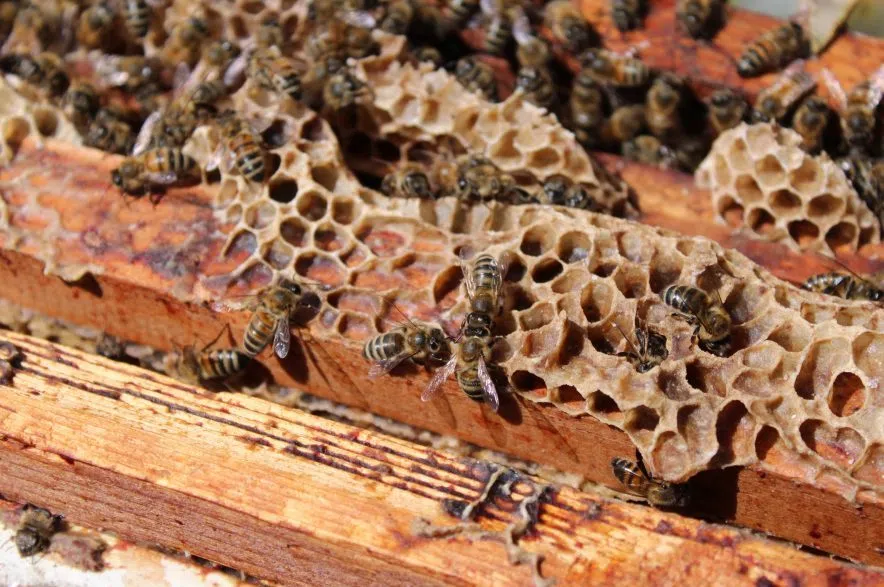
Every hive carries lessons from decades of experience. Lessons Murray learned from his father about patience, flexibility and quiet perseverance. (Brittany Caffet/650 CKOM)
Summers weren’t for lakeside weekends. They were go-time — long days in the fields, responding to the bees, the bloom, the wind. But winter? That was the time to breathe, regroup and plan again.
“Beekeepers don’t usually have cabins at the lake,” Murray said with a laugh. “That’s a winter thing — the lakes are frozen. But summer? Summer is for the bees.”
Whether it was dealing with unpredictable swarms, ornery queens or uninvited bears, Albert handled every curve ball with patience and grit. Flexibility wasn’t just a survival tactic — it was a way of respecting the natural rhythms around him.

At the honour system store at the Hannigan Honey processing plant, the rules are simple: take what you need, leave what you owe. It’s a system built on trust — just the way Albert Hannigan liked it. (Brittany Caffet/650 CKOM)
Lesson five: Good honey starts with good company
Albert didn’t just build hives. He built relationships.
“He’d visit people in the hospital and sing to them,” Murray recalled. “So many people in Shellbrook knew him.”
That reputation, built on kindness and credibility, still echoes through the business today. From neighbours to customers to farmers hosting hives on their land, relationships are the quiet engine behind Hannigan Honey.
“Some of those relationships go back over 30 years,” Murray said. “Before Christmas, we stop by with a case of honey and a letter about how the year went. It’s our way of staying connected.”
